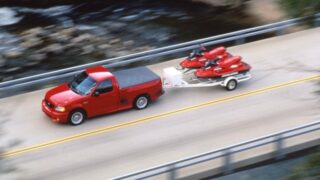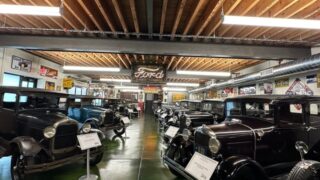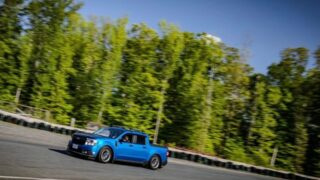|
I just purchased a 70 F-100 Ranger XLT. It was a year out of inspection, and when I bought it, the rear lights did not work at all, so I knew it would need some work to be drivable. The front parking lights did work on this vehicle. The procedures and wire colors used here will apply to at least 70-74 trucks, as I used a 74 wiring diagram to diagnose my problems.
To diagnose your truck, you will need:
- screwdrivers
- one or both of the following electrical testing devices
- a multimeter either
- test lamp
Some tests are not doable or are much more difficult to do with a test light. Some are easier with a test light. So having both will be better.
To use your multimeter to check voltage at a given point:
- Set range to the lowest scale that is still over +12V. On my multimeter the range setting is +20V.
- Connect the black wire to the ground terminal of the multimeter.
- Connect the red wire to the + terminal of the multimeter.
- Connect the other end of the black wire to a good ground (bare metal or a bolt usually works.)
- Connect the other end of the red wire to the electrical connection you want to test (lamp socket or terminal junction.)
The number shown on the meter is the amount of volts available at that point. If the number is over 11.5V, then everything is OK. If it is zero, then that point is not getting power. If it is getting a number between 0.5 and 11.5 then there is either a short or something causing high resistance (poor splice, corroded wire, or bad switch) in the circuit before the point you are testing. The lower the number the worse the problem is and the easier it will be to find.
To check for voltage with a test light at a given point:
- Clip the black wire to a good ground (as above.)
- Touch the point to the terminal/wire being tested.
If the light lights, the circuit is getting power. Notice you don’t get as much information from the test lamp.
To check continuity with a multimeter:
- Connect the black wire to the ground terminal of the meter.
- Connect the red wire to the amp/ohm terminal.
- Set the range to a low one, less than 100 ohms. If your meter is analog, touch the wires together and set the meter to zero.
- To test:
- touch the black wire to one terminal of the switch
- the red wire to the other terminal
If you get 0-2 ohms, then there is continuity, if the reading is infinity, then there is no continuity. If the reading is between 5-200 then there is high resistance in that circuit. Test a switch in both position to verify it works.
Diagnosis phase one: Since my front turn signals didn’t work either, my first step was to look in the fuse box. Sure enough, the turn signal fuse was blown. I replaced it with the appropriate fuse, and the front turn signals started working. The rear lights still didn’t work at all.
Diagnosis phase two: The next step was to see if I was getting +12V power in the lines to the rear of the truck. I removed the taillight lens and used a digital multimeter with one lead attached to ground, and one lead attached to the appropriate socket in the lens holder. For this test, I had the parking lights on, and the hazard lights on, which causes the rear stop light circuit to flash. This way if you get power at one terminal and not the other at the back you know which one is causing problems. If you get steady +12V, you know the parking light wires are transmiting signal, and if you have flashing +12V, the stop light circuit is working.
In my case neither one was working, so I checked the wire that runs along side of the left frame rail. Sure enough, a section of wire near the custom dual exhaust was all frazzled and the insulation melted. I cut the wire there and removed about 3 feet of the harness.
This leads to what will be step one of the fix: repairing the rear wiring.
I followed the rear wiring from the point I cut forwards towards the front of the truck. I eventually came to a connector on the driver’s side front fender.

Unplugging this connector provides a convienent place to check for power to the rear circuits.

On this connector are four wires.
- The yellow/black stripe is for the Left rear stop/turn lamp.
- Green is for the Right rear turn/stop lamp.
- Brown is for the parking lamps.
- Black with red stripe is for the reverse lights.
Turn on the parking lights and first one side of the turn signals and then the other. Put the truck in reverse. Once again use the multimeter to test the various sockets, or use a test lamp. I used a test lamp. My rear parking lights and the right side turn signal worked at this point in the circuit.
Diagnosis phase three: At this time I decided to check the brake lights. On the back of the brake pedal bracket is a electrical switch. This switch controls the brake light operation. I unplugged the electrical connection to the switch and checked the voltage. One side had +12V and one didn’t, which is just how is should be. I checked the switch for continuity, and when released it had continuity, and when depressed it didn’t. This is also functioning correctly. I followed the wire to where it lead into the column and it had +12V at the terminal near the column.
So at this point we have figured out that the turn signal doesn’t work on one side and the brake lights still don’t work, but they do have power at the switch and the switch does work. The last place in the system that the brake and turn signals are connected is in the turn signal switch, so that’s where we’ll look next.
Diagnosis phase four: The turn signal switch. The connector for the turn signal switch is located just to the left of the column under the dash.

If you have a multimeter you can test the switch easily with the connector unplugged. If you have a test light it is more difficult, but you can insert the probe in the terminal with it still plugged in and test.
There are 7 wires to the turn signal switch, here is a description of each:
- Blue/yellow stripe: horn.
- Blue: +12V power from turn flasher for turn signals
- Black/red stripe: +12V power from stop lamp switch for stop lamps
- Green: Rear right turn/stop lamp
- White/Blue stripe: Front right turn lamp
- Yellow/black stripe: Rear left turn/stop lamp
- Green/white stripe: Front left turn lamp
Here’s how it works:
- When the turn signal is off, both rear stop/turn lamps are connected to the stop lamp switch. To test with multimeter, check for continuity between the red/black wire and the yellow/black and the red/black and the green wire. Lack of continuity indicates a bad switch. To check with a test light, clip the ground wire onto one. Put the probe end into the yellow//black wire slot of the connector (either side.) Press down on the brake, if the light illuminates that side works. Next do the green wire the same way.
- When you turn left, the connection on the left rear is broken with the stop lamp, and it is connected to the turn flasher, along with the front left turn lamp. Turn the lever to indicate a left turn. Now check for continuity between the blue wire and the yellow/black wire and the blue wire and green/white wire. Lack of continuity indicates a bad switch. There should still be continuity between the red/black and the green wire. To test with a test light, turn on the turn signals (and turn the key on so they work) and indicate a left turn. When you insert the probe into the yellow/black wire slot of the connector or green/white wire slot the test light should flash. Put it in the green wire slot and press the stop pedal, it should light.
- When you turn right, the connection on the right rear is broken with the stop lamp, and it is connected to the turn flasher, along with the front right turn lamp. Turn the lever to indicate a right turn. Now check for continuity between the blue wire and the white/blue wire and the blue wire and green wire. Lack of continuity indicates a bad switch. There should still be continuity between the red/black and the yellow/black wire. To test with a test light, turn on the turn signals (and turn the key on so they work) and indicate a right turn. When you insert the probe into the white/blue wire slot of the connector or green wire slot the test light should flash. Put it in the yellow/black wire slot and press the stop pedal, it should light.
On my truck, there was no continuity with the stop lamp switch and either stop lamp, and no continuity with the blue wire and the yellow/black (turn signal power and left rear turn lamp.)
So to fix my truck I will need to replace the turn signal switch and repair the wiring where I chopped out a section.
My diagnosis of what went wrong:
I removed the turn signal switch and looked at it. I offer the following complete diagnosis of my truck electrical system failure.
The hot exhaust system burned the insulation off the wires in the back of the truck. The stop lamp shorted enough to cause constant current flow through the turn signal switch. The heat generated by this eventually warped the plastic enough to cause the stop lamps to stop working. In doing this is also shorted out the yellow/black wire, which also burned out on the switch. When the turn signal was engaged, it popped the fuse. So a rerouting of the wires in the back is in order (or maybe a heat shield.) for a complete repair.
One week later, the repair:
The turn signal switch arrived in the middle of the week, and I finally got around to finishing the repair. To replace the turn signal switch requires removing the steering wheel and disassembling the upper part of the steering column. To do this:
- Remove the horn button.
- Remove the horn stuff (I don’t have it on my column, so I can’t really tell you how)
- Unbolt the steering wheel. Remove the spring and spacer (if you can, if not, grab them as they fall in step 9)
- Use a puller and remove the steering wheel (harmonic balancer type worked on mine, and is what I usually use for steering wheels.)
- Now look at the bottom left of the steering column, find and unplug the turn signal switch connector from the truck harness.
- Using a small flat head screwdriver, press down on the tang that holds each wire’s end into the terminal connector. (its pretty easy once you see it)
- Pull each wire out of the terminal connector.
- Tie a long wire or string to the bundle of wires. Make sure it is tight, as the wires must pass through a small slot on each end of the column.
- Now you should be able to pull the part of the column that holds the turn signal switch out, and the wiring with it.
- The turn signal switch is held in with three screws and a metal plate. To access the two left screws, you must turn the switch left and right. Remove the screws and the plate.
- Unscrew the turn signal arm from the switch. There is a flat on it for a wrench if you need it.
- Lift the turn signal switch out of the metal piece. Pay attention to which hole the wiring goes through, when you put in the new switch, use the same hole.
- Put in the new switch, it goes in just like the one your removed.
- Screw in the lever.
- Attach plate with the screws.
- Now attach the new wires to the wire/string used to pull the wires through the column.
- Push down the shroud at the base of the column area you are working on. It need to go down far enough that the wires will feed through the column easily.
- Pull on the string gently until the wires emerge from the bottom of the column. There is enough wire that the turn signal metal piece does not have to be against the column to pull it through. Unbolting the two column to dash bolt may make it easier.
- Pull the wires coming out the bottom as far as you can. Align the turn signal assembly with the column and slide it down as far as it will go.
- The next part is the trickiest. You have to get the lower shroud, the column shifter tube, and the turn signal assembly aligned just right, then put the spring spacer, the spring, the steering wheel and nut on all at the same time. I found the I could hold the steering wheel with my knees while I put the nut on. If you have trouble getting the steering wheel down all the way, the column shift tube may not be fully engaged, it will slip down part way and turn the lever at the bottom of the column, but still not be engaged fully. You can tell when it is fully engaged when the column shroud fits below the visible wear marks on the column, and is past the wiring the goes into the upper column. Tighten down the steering wheel nut.
- Put the horn back together, then the button.
- Plug the terminal connector back into the truck harness (that’s right, before you put the wires in it.) It will only go in one way.
- Grab the bundle of loose wires. Stick each one into the terminal connector so that the wire color corresponds. If you screw up, unplug the connector and use the small screwdriver as in the disassembly to correct your misteak.
- Bolt the column back to the dash if you unbolted it.
- Finished.
The last step was to repair the wiring under the truck. The wires from the old turn signal switch had mostly the right colors (exactly right for the stop/turn lamps on both sides) and were exactly the right length, so I used them for the splice. I used heat shrink tube every 12 inches on the spliced section to keep the wires together. I used a few wire ties to keep the wires right up against the frame.
I plugged the connector under the hood back in, put the bulbs in the socket, and put the tail light lens on. Into the cab I went to flip switches. Everything worked just like it should, all lights blinking and illuminating just like they should. Another successful repair.

|








